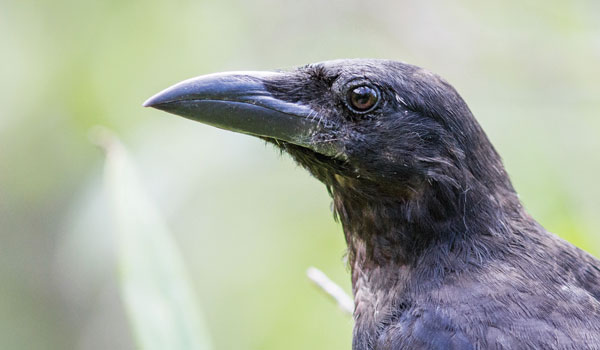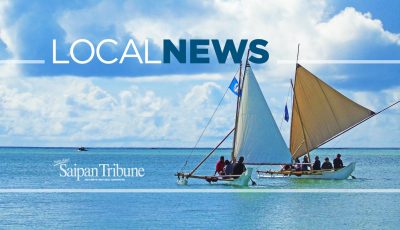Bringing back the endangered åga

The Mariana crow, or åga in Chamorro, has declined over 80% since the 1980s. Now only found in Rota, the community is working to bring back its population, through the Mariana Crow Recovery Project. (Henry Fandel)
ROTA—Rota is working to bring back the population of one of its threatened species, the åga, more commonly known as the Mariana Crow.
Saipan Tribune went to Rota and sat with Henry Fandel and Dylan Hubl, crew leaders of the University of Washington’s Mariana Crow Recovery Project, or the Åga Project, who have been working with the island community of Rota, to protect the åga.
They are contracted by the Department of Land and Natural Resources, through its Division of Fish and Wildlife, to monitor the åga, through nest searching and surveys, to keep track of the trend over time whether its population is increasing, decreasing, or remaining stable.
“Our major goal is to keep track of the åga population so that we know how imperiled it is,” Fandel said. “Over time, in the past, it has been declining really rapidly. We have been tasked with trying to figure out why that is.”
Endemic to the Marianas, the åga originally were found only in Guam and Rota. They are no longer in Guam, making its population on Rota even more important as it is the last remaining population of the crow.
The åga is a member of the Rota ecological community, where each member provides services to the island’s ecosystem in general.
“So this fight is a fight to preserve the ecological identity of the Marianas,” Fandel added.
“The more we’re able to do that, the more intact things will be, the more what makes the Marianas unique will remain, what makes it function ecologically will remain. These are all very good things for people.”
Their team is currently doing a release of first-year birds, or 1-year-old birds. They collect eggs and nestlings which are then raised for a year and a half by a Rota-stationed team from the San Diego Zoo, before they get released in the wild.
“We released seven birds in the end of November and then [this] year, we are having another cohort, which will be the third release,” Hubl said.
“We did one prior last year. That was 10 birds in 2018, 13 birds in 2019, and then 13 or 14, this year. These are birds that mostly came from wild eggs that were then reared in captivity.”
The åga is a member of the Corvid family which is known for being extremely intelligent, which makes them academically of interest to people who are into studying animal intelligence.
One of the main foundations of the Åga Project is the monitoring of nests because that leads to banding opportunities, which adds data points to the team’s data set of known birds.
This data helps in tracking the population of the åga, particularly where they are going, who they are associating with, and if they are nesting.
The team is particularly grateful to the people of Rota, particularly the land owners who have allowed them to conduct surveys in their properties.
“We very much appreciate the land owners that have allowed us to come on to their properties and allowed us to do surveys. It is very helpful to the project. Land owners that have taken us in and let us use their property. It’s been amazing,” Hubl said.
“This project is totally a partnership,” Fandel stressed, emphasizing that while their team from the University of Washington work in collaboration with the San Diego Zoo, it is the people of Rota who are helping them access the places that they need to, to help save the åga.
As the team looks forward to yet another full year of nest searching, monitoring, and bird release, Fandel could not stress enough the pride of having the åga, and the significance of bringing back up its population.
“The åga is Rota’s crow. It is the Marianas Crow. It doesn’t belong anywhere else. It is the bird for the people of Rota, for the people of the Marianas,” said Fandel.
To get updates on the Åga Project, visit https://www.facebook.com/MarianaCrowRecoveryProject/.



























